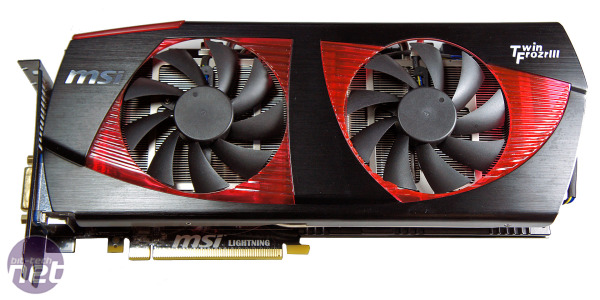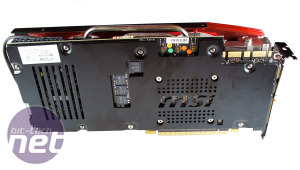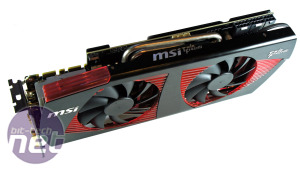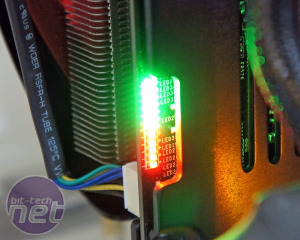Preview: MSI N480GTX Lightning
Manufacturer: MSIMSI's graphics division is certainly getting bolder in its designs, and the latest N480GTX Lightning is definitely pushing the boundaries of engineering. The Lightning is clearly in the same market as ASUS RoG series cards, such as the Mars and Ares, for example.
While there are distinct differences in the design approaches, there are also hints of familiarity. MSI is choosing to spend its time re-engineering and improving a reference model rather than committing to an entire redesign, but both companies are going for the 'use straight out the box' approach with greatly improved air-cooling rather than a waterblock.

The N480GTX Lightning PCB is 28cm long, but the TwinFrozr III cooler juts out, pushing the card to 29cm in length
Asus' approach is to also charge an astronomical price for a limited series, and that works for them, but MSI is still keeping its feet on the ground with its N480GTX Lightning. It should retail for around $550.
That's not to say that the N480GTX Lightning is cheap, but you do get a ton (or at least a couple of kg) of high-end hardware for your money. While a waterblock might provide cooler temperatures and potentially higher frequencies, the TwinFrozr III air-cooler means you can use the card straight away and helps keep that price in check. This is also not the first time we've heard a manufacturer claim too few people water-cool, and MSI wants the card to be a viable retail product.
That said, the cooler has plus sides and down sides; firstly we think MSI made a mistake with going for a plastic-and-metal shroud. The metal of the TwinFrozr II shroud (featured on cards such as the HD 5870 Lightning) looked more luxurious - the plastic elements of the TwinFrozr III cooler let it down a touch. We do appreciate a new design was needed to accommodate greater heat dispersal, but as this is the cooler is the main area that you touch and see, we don't expect a few dollars of penny-pinching on such a premium product.
The rear of the card also gets an MSI-branded cover-plate. This is to give the card a few millimetres of air gap and protect it from other heat sources leaning on it. We've already read some concerns about creating insulating air pockets, but it's simply not the case. During testing, the whole rear side of the card was one uniform temperature, although, like the rest of the card it certainly wasn't cool. But hey, it is a GTX 480!
The TwinFrozr III heatsink runs the entire length of the card and has five fat heatpipes with two thin 90mm fans. However, the chunky heatsinks is held on with just four small screws around the GPU socket. Yikes!
On one hand that makes replacing the cooler with a GPU-only waterblock really easy, as the memory and power hardware are all cooled by a separate aluminium sheet. On the other hand, the heatsink is a massive chunk of metal that exerts considerable stress on the PCB around the GPU. We wonder how many might suffer cracked solder joints underneath.
Questions of long term reliability aside, we've found the card is notably cooler and significantly quieter than a stock GTX 480 during gaming. Don't get us wrong, MSI hasn't filled the N480GTX Lightning with magical sprinkles; the whole card still gets hot just like any GF100 part. The TwinFrozr III cooler is much better than the standard cooler, but as there's no rear exhaust all that GTX 480 heat gets pumped straight back into your case. This means that you'll need at least a reasonably high-ariflow case to handle the N480GTX Lightning.

MSI MPG Velox 100R Chassis Review
October 14 2021 | 15:04













Want to comment? Please log in.